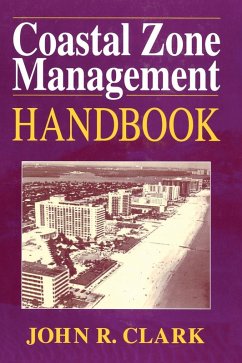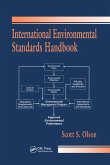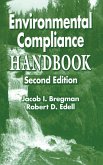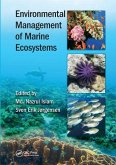Coastal Zone Management Handbook
Herausgeber: Clark, John R.
Coastal Zone Management Handbook
Herausgeber: Clark, John R.
- Gebundenes Buch
- Merkliste
- Auf die Merkliste
- Bewerten Bewerten
- Teilen
- Produkt teilen
- Produkterinnerung
- Produkterinnerung
This book describes a strategy for a comprehensive coastal resources planning and management and provides a set of working tools along with a detailed information base for the practitioner. It presents mini-case histories of coastal zone situations along with management techniques and their trials.
Andere Kunden interessierten sich auch für
![International Environmental Standards Handbook International Environmental Standards Handbook]() Scott S. OlsonInternational Environmental Standards Handbook72,99 €
Scott S. OlsonInternational Environmental Standards Handbook72,99 €![Global Occupational Safety and Health Management Handbook Global Occupational Safety and Health Management Handbook]() Global Occupational Safety and Health Management Handbook261,99 €
Global Occupational Safety and Health Management Handbook261,99 €![The Copyright Zone The Copyright Zone]() Edward GreenbergThe Copyright Zone206,99 €
Edward GreenbergThe Copyright Zone206,99 €![Land Use Planning, Environmental Protection and Growth Management Land Use Planning, Environmental Protection and Growth Management]() Robert A CatlinLand Use Planning, Environmental Protection and Growth Management74,99 €
Robert A CatlinLand Use Planning, Environmental Protection and Growth Management74,99 €![Environmental Compliance Handbook Environmental Compliance Handbook]() Jacob I. BregmanEnvironmental Compliance Handbook317,99 €
Jacob I. BregmanEnvironmental Compliance Handbook317,99 €![Environmental Management Environmental Management]() Louis TheodoreEnvironmental Management75,99 €
Louis TheodoreEnvironmental Management75,99 €![Environmental Management of Marine Ecosystems Environmental Management of Marine Ecosystems]() Environmental Management of Marine Ecosystems101,99 €
Environmental Management of Marine Ecosystems101,99 €-
-
-
This book describes a strategy for a comprehensive coastal resources planning and management and provides a set of working tools along with a detailed information base for the practitioner. It presents mini-case histories of coastal zone situations along with management techniques and their trials.
Hinweis: Dieser Artikel kann nur an eine deutsche Lieferadresse ausgeliefert werden.
Hinweis: Dieser Artikel kann nur an eine deutsche Lieferadresse ausgeliefert werden.
Produktdetails
- Produktdetails
- Verlag: CRC Press
- Seitenzahl: 718
- Erscheinungstermin: 27. November 1995
- Englisch
- Abmessung: 260mm x 183mm x 43mm
- Gewicht: 1522g
- ISBN-13: 9781566700924
- ISBN-10: 1566700922
- Artikelnr.: 21447329
- Herstellerkennzeichnung
- Produktsicherheitsverantwortliche/r
- Europaallee 1
- 36244 Bad Hersfeld
- gpsr@libri.de
- Verlag: CRC Press
- Seitenzahl: 718
- Erscheinungstermin: 27. November 1995
- Englisch
- Abmessung: 260mm x 183mm x 43mm
- Gewicht: 1522g
- ISBN-13: 9781566700924
- ISBN-10: 1566700922
- Artikelnr.: 21447329
- Herstellerkennzeichnung
- Produktsicherheitsverantwortliche/r
- Europaallee 1
- 36244 Bad Hersfeld
- gpsr@libri.de
Clark\, John R.
Part I: Management Strategies 1. Introduction 2. Management Goals and
Purposes 3. Development Impacts 4. Solutions Through Management 5. Strategy
Planning 6. Program Development Part II: Management Methods 7. Aquaculture
Management 8. Awareness 9. Baseline and Monitoring 10. Beach Management 11.
Boundaries 12. Construction Management 13. Coral Reef Management 14. Coral
Reef Survey Methods 15. Ecologically Critical Areas Identification 16.
Database Development 17. Dredging Management 18. Dune Management 19.
Economic Impact Assessment 20. Environmental Assessment 21. Environmental
Management Plan 22. Floodlands 23. Historical-Archaeological Sites Impact
Assessment 24. Institutional Analysis 25. Issues Analysis 26. Mangrove
Forest Management 27. Master Plan 28. Mapping 29. Mitigation 30. Monitoring
and Baseline 31. Nutrients Management 32. Ocean Outfall Placement 33.
Oxygen: Bod/Cod Measurement 34. Project Review and Permits 35. Protected
Natural Areas 36. Public Participation in Planning 37. Rehabilitation 38.
Retreat 39. Septic Tanks Placement 40. Setbacks 41. Sewage Management 42.
Shoreline Construction Management 43. Situation Management 44. Social
Impact Assessment 45. Strategy Plan 46. Tiers For Management 47.
Traditional Use Arrangements 48. Turbidity Measurement 49. Urban Runoff
Management 50. Water Quality Management: Coastal Waters 51. Water Quality
Management: Coral Reefs 52. Zoning Part III: Management Information 53.
Agriculture 54. Airfields 55. Alternate Livelihoods 56. Aquaculture 57.
Artificial Reefs 58. Barrier Islands 59. Beach Erosion 60. Beach Fill 61.
Beach Resources 62. Biological Diversity 63. Biosphere Reserves 64.
Biotoxins 65. Carrying Capacity 66. Ciguatera 67. Cites 68. The Commons 69.
Conflict Resolution 70. Coral Reef Resources 71. Cyclones, Hurricanes, and
Typhoons 72. Decentralized Management 73. Diversity Index 74. Dredging
Techniques 75. Dynamite Fishing 76. Ecodevelopment 77. Economic Benefits of
Protected Areas 78. Economic Valuation 79. Ecosystems 80. Ecotourism 81.
Education 82. Electric Power Generation 83. Endangered Species 84.
Environmental Audit 85. Eutrophication 86. Exclusive Economic Zone 87.
Exotics 88. Explosives 89. Fisheries 90. Genetic Diversity 91. Geographic
Information Systems (Gis) 92. Global Warming 93. Greenbelt 94. Impact Types
95. Indicator Species 96. Industrial Pollution 97. Information Needs 98.
Inlets 99. International Assistance Agencies 100. Kelp Beds 101. Lagoons,
Estuaries, and Embayments 102. Littoral Drift 103. Mangrove Forest
Resources 104. Marinas 105. Marshlands 106. Mining 107. Multiple Use of
Resources 108. Multiple-Use Management Authorities 109. Natural Hazards
110. Nature Synchronous Design 111. Noise and Disturbance 112. Nurture
Areas 113. Oxygen 114. Participation 115. Pathogens 116. Performance
Standards 117. Petroleum Industries 118. Political Motivation 119.
Pollution 120. Ports and Harbors 121. Principles and Premises 122. Ramsar
Convention 123. Rapid Rural Appraisal 124. Red Tide 125. Regional
Development Planning 126. Remote Sensing 127. Research Needs 128.
Restoration and Rehabilitation 129. Risk Assessment 130. Roadways,
Causeways, and Bridges 131. Salinity 132. Saltwater Intrusion 133. Sand
Mining 134. Seagrass Meadows 135. Sea Level Rise 136. Sediments and Soils
137. Settlements 138. Sewage Treatment 139. Shellfish Pollution 140. Site
Management and Housekeeping 141. Social Equity 142. Socio-Economic Factors
143. Solid Wastes 144. Storm Surge 145. Subsidence 146. Suspended
Particulate Matter 147. Sustainable Use 148. Terms of Reference 149.
Tideflats 150. Tides 151. Tourism 152. Toxic Substances 153. Traditional
Uses 154. Training 155. Transparency of Water 156. Tsunamis 157. Turtles
158. Underwater Fishing 159. Watersheds and Upland Effects 160. Waves 161.
Wetlands 162. Zona Publica Part IV: Case Histories 163. Australia, Clarence
Estuary: Unguided Tourism Development 164. Australia: Coral Reef Survey
Methodology 165. Australia, The Great Barrier Reef: Multiple-Use Management
166. Australia, Port Phillip Bay: A Failed Authority 167. Barbados: An
Example of Incremental Coastal Management 168. Bermuda: Tourism Carrying
Capacity and Cruise Ships 169. Bonaire: Carrying Capacity Limits to
Recreational Use 170. Canada: Offshore Sewage Outfall at Victoria, Bc 171.
Canada: National Experience with Coastal Zone Management 172. China:
Prospects for Integrated Coastal Zone Management 173. Costa Rica:
Controlling the Zona Publica 174. Ecuador: Integrated Coastal Resources
Management Program 175. Egypt, Sinai: The Lake Bardawil Situation 176.
Grenada: Building Setback Policy 177. India: Mangrove Planting Technique
for the Gulf of Kutch 178. Indonesia, Bali: Beach Damage and Rehabilitation
179. Indonesia, Java: Multiple Use of a Mangrove Coastline 180. Indonesia,
Sulawesi: Ocean Disposal of Harbor Silt 181. Italy, Venice: A City at
Risk From Sea-Level Rise 182. Malaysia, Pulau Bruit: The Disappearing
National Park 183. Maldives: An Informal Approach to Coastal Management
184. Mexico, Cancun: Coastal Tourism Threatens a Prime Lagoon 185. Mexico,
Yucatan: Provincial Coastal Zone Management 186. Netherlands: Environmental
Priority for Delta Plan 187. Oman: Coastal Management by Networking 188.
Philippines, Palawan: Economic Analysis of Resource Conflict 189.
Philippines: Community Management of Coral Reef Resources 190. St Lucia:
Community Participation in Resources Management 191. Solomon Islands:
Social Chaos From Tourism 192. South Pacific: Coastal Construction Impacts
193. Sri Lanka: Issue-Driven Coastal Management 194. Tanzania, Mafia
Island: Participatory Control of Coral Mining 195. Thailand: Shipping Ports
and Cumulative Impacts 196. Thailand: Tantalum Riot at Phuket 197.
Thailand: Trouble With Managing Coastal Aquaculture 198. Trinidad And
Tobago: A Small Country Tests and Rejects Integrated Management 199. Turks
And Caicos: Restoring Wetlands with Mining Effluent 200. United States: A
National Coastal Management Program 201. United States, Alaska:
Participatory Coastal Zone Management 202. United States, Florida: Distant
Influence on Coral Reefs 203. United States, Florida: Success with Ocean
Outfalls 204. United States, Hawaii: Monitoring New Harbor Coral Growth
205. United States, Hawaii: Success With Kaneohe Bay Ocean Outfall 206.
United States, Hawaii: Tourism Threatens Haunama Bay 207. United States,
South Carolina: Soft Engineering Beach Restoration 208. Vietnam, Mekong:
Difficulty of Repairing Damaged Wetlands 209. West Indies: Monitoring
Coastal Erosion
Purposes 3. Development Impacts 4. Solutions Through Management 5. Strategy
Planning 6. Program Development Part II: Management Methods 7. Aquaculture
Management 8. Awareness 9. Baseline and Monitoring 10. Beach Management 11.
Boundaries 12. Construction Management 13. Coral Reef Management 14. Coral
Reef Survey Methods 15. Ecologically Critical Areas Identification 16.
Database Development 17. Dredging Management 18. Dune Management 19.
Economic Impact Assessment 20. Environmental Assessment 21. Environmental
Management Plan 22. Floodlands 23. Historical-Archaeological Sites Impact
Assessment 24. Institutional Analysis 25. Issues Analysis 26. Mangrove
Forest Management 27. Master Plan 28. Mapping 29. Mitigation 30. Monitoring
and Baseline 31. Nutrients Management 32. Ocean Outfall Placement 33.
Oxygen: Bod/Cod Measurement 34. Project Review and Permits 35. Protected
Natural Areas 36. Public Participation in Planning 37. Rehabilitation 38.
Retreat 39. Septic Tanks Placement 40. Setbacks 41. Sewage Management 42.
Shoreline Construction Management 43. Situation Management 44. Social
Impact Assessment 45. Strategy Plan 46. Tiers For Management 47.
Traditional Use Arrangements 48. Turbidity Measurement 49. Urban Runoff
Management 50. Water Quality Management: Coastal Waters 51. Water Quality
Management: Coral Reefs 52. Zoning Part III: Management Information 53.
Agriculture 54. Airfields 55. Alternate Livelihoods 56. Aquaculture 57.
Artificial Reefs 58. Barrier Islands 59. Beach Erosion 60. Beach Fill 61.
Beach Resources 62. Biological Diversity 63. Biosphere Reserves 64.
Biotoxins 65. Carrying Capacity 66. Ciguatera 67. Cites 68. The Commons 69.
Conflict Resolution 70. Coral Reef Resources 71. Cyclones, Hurricanes, and
Typhoons 72. Decentralized Management 73. Diversity Index 74. Dredging
Techniques 75. Dynamite Fishing 76. Ecodevelopment 77. Economic Benefits of
Protected Areas 78. Economic Valuation 79. Ecosystems 80. Ecotourism 81.
Education 82. Electric Power Generation 83. Endangered Species 84.
Environmental Audit 85. Eutrophication 86. Exclusive Economic Zone 87.
Exotics 88. Explosives 89. Fisheries 90. Genetic Diversity 91. Geographic
Information Systems (Gis) 92. Global Warming 93. Greenbelt 94. Impact Types
95. Indicator Species 96. Industrial Pollution 97. Information Needs 98.
Inlets 99. International Assistance Agencies 100. Kelp Beds 101. Lagoons,
Estuaries, and Embayments 102. Littoral Drift 103. Mangrove Forest
Resources 104. Marinas 105. Marshlands 106. Mining 107. Multiple Use of
Resources 108. Multiple-Use Management Authorities 109. Natural Hazards
110. Nature Synchronous Design 111. Noise and Disturbance 112. Nurture
Areas 113. Oxygen 114. Participation 115. Pathogens 116. Performance
Standards 117. Petroleum Industries 118. Political Motivation 119.
Pollution 120. Ports and Harbors 121. Principles and Premises 122. Ramsar
Convention 123. Rapid Rural Appraisal 124. Red Tide 125. Regional
Development Planning 126. Remote Sensing 127. Research Needs 128.
Restoration and Rehabilitation 129. Risk Assessment 130. Roadways,
Causeways, and Bridges 131. Salinity 132. Saltwater Intrusion 133. Sand
Mining 134. Seagrass Meadows 135. Sea Level Rise 136. Sediments and Soils
137. Settlements 138. Sewage Treatment 139. Shellfish Pollution 140. Site
Management and Housekeeping 141. Social Equity 142. Socio-Economic Factors
143. Solid Wastes 144. Storm Surge 145. Subsidence 146. Suspended
Particulate Matter 147. Sustainable Use 148. Terms of Reference 149.
Tideflats 150. Tides 151. Tourism 152. Toxic Substances 153. Traditional
Uses 154. Training 155. Transparency of Water 156. Tsunamis 157. Turtles
158. Underwater Fishing 159. Watersheds and Upland Effects 160. Waves 161.
Wetlands 162. Zona Publica Part IV: Case Histories 163. Australia, Clarence
Estuary: Unguided Tourism Development 164. Australia: Coral Reef Survey
Methodology 165. Australia, The Great Barrier Reef: Multiple-Use Management
166. Australia, Port Phillip Bay: A Failed Authority 167. Barbados: An
Example of Incremental Coastal Management 168. Bermuda: Tourism Carrying
Capacity and Cruise Ships 169. Bonaire: Carrying Capacity Limits to
Recreational Use 170. Canada: Offshore Sewage Outfall at Victoria, Bc 171.
Canada: National Experience with Coastal Zone Management 172. China:
Prospects for Integrated Coastal Zone Management 173. Costa Rica:
Controlling the Zona Publica 174. Ecuador: Integrated Coastal Resources
Management Program 175. Egypt, Sinai: The Lake Bardawil Situation 176.
Grenada: Building Setback Policy 177. India: Mangrove Planting Technique
for the Gulf of Kutch 178. Indonesia, Bali: Beach Damage and Rehabilitation
179. Indonesia, Java: Multiple Use of a Mangrove Coastline 180. Indonesia,
Sulawesi: Ocean Disposal of Harbor Silt 181. Italy, Venice: A City at
Risk From Sea-Level Rise 182. Malaysia, Pulau Bruit: The Disappearing
National Park 183. Maldives: An Informal Approach to Coastal Management
184. Mexico, Cancun: Coastal Tourism Threatens a Prime Lagoon 185. Mexico,
Yucatan: Provincial Coastal Zone Management 186. Netherlands: Environmental
Priority for Delta Plan 187. Oman: Coastal Management by Networking 188.
Philippines, Palawan: Economic Analysis of Resource Conflict 189.
Philippines: Community Management of Coral Reef Resources 190. St Lucia:
Community Participation in Resources Management 191. Solomon Islands:
Social Chaos From Tourism 192. South Pacific: Coastal Construction Impacts
193. Sri Lanka: Issue-Driven Coastal Management 194. Tanzania, Mafia
Island: Participatory Control of Coral Mining 195. Thailand: Shipping Ports
and Cumulative Impacts 196. Thailand: Tantalum Riot at Phuket 197.
Thailand: Trouble With Managing Coastal Aquaculture 198. Trinidad And
Tobago: A Small Country Tests and Rejects Integrated Management 199. Turks
And Caicos: Restoring Wetlands with Mining Effluent 200. United States: A
National Coastal Management Program 201. United States, Alaska:
Participatory Coastal Zone Management 202. United States, Florida: Distant
Influence on Coral Reefs 203. United States, Florida: Success with Ocean
Outfalls 204. United States, Hawaii: Monitoring New Harbor Coral Growth
205. United States, Hawaii: Success With Kaneohe Bay Ocean Outfall 206.
United States, Hawaii: Tourism Threatens Haunama Bay 207. United States,
South Carolina: Soft Engineering Beach Restoration 208. Vietnam, Mekong:
Difficulty of Repairing Damaged Wetlands 209. West Indies: Monitoring
Coastal Erosion
Part I: Management Strategies 1. Introduction 2. Management Goals and
Purposes 3. Development Impacts 4. Solutions Through Management 5. Strategy
Planning 6. Program Development Part II: Management Methods 7. Aquaculture
Management 8. Awareness 9. Baseline and Monitoring 10. Beach Management 11.
Boundaries 12. Construction Management 13. Coral Reef Management 14. Coral
Reef Survey Methods 15. Ecologically Critical Areas Identification 16.
Database Development 17. Dredging Management 18. Dune Management 19.
Economic Impact Assessment 20. Environmental Assessment 21. Environmental
Management Plan 22. Floodlands 23. Historical-Archaeological Sites Impact
Assessment 24. Institutional Analysis 25. Issues Analysis 26. Mangrove
Forest Management 27. Master Plan 28. Mapping 29. Mitigation 30. Monitoring
and Baseline 31. Nutrients Management 32. Ocean Outfall Placement 33.
Oxygen: Bod/Cod Measurement 34. Project Review and Permits 35. Protected
Natural Areas 36. Public Participation in Planning 37. Rehabilitation 38.
Retreat 39. Septic Tanks Placement 40. Setbacks 41. Sewage Management 42.
Shoreline Construction Management 43. Situation Management 44. Social
Impact Assessment 45. Strategy Plan 46. Tiers For Management 47.
Traditional Use Arrangements 48. Turbidity Measurement 49. Urban Runoff
Management 50. Water Quality Management: Coastal Waters 51. Water Quality
Management: Coral Reefs 52. Zoning Part III: Management Information 53.
Agriculture 54. Airfields 55. Alternate Livelihoods 56. Aquaculture 57.
Artificial Reefs 58. Barrier Islands 59. Beach Erosion 60. Beach Fill 61.
Beach Resources 62. Biological Diversity 63. Biosphere Reserves 64.
Biotoxins 65. Carrying Capacity 66. Ciguatera 67. Cites 68. The Commons 69.
Conflict Resolution 70. Coral Reef Resources 71. Cyclones, Hurricanes, and
Typhoons 72. Decentralized Management 73. Diversity Index 74. Dredging
Techniques 75. Dynamite Fishing 76. Ecodevelopment 77. Economic Benefits of
Protected Areas 78. Economic Valuation 79. Ecosystems 80. Ecotourism 81.
Education 82. Electric Power Generation 83. Endangered Species 84.
Environmental Audit 85. Eutrophication 86. Exclusive Economic Zone 87.
Exotics 88. Explosives 89. Fisheries 90. Genetic Diversity 91. Geographic
Information Systems (Gis) 92. Global Warming 93. Greenbelt 94. Impact Types
95. Indicator Species 96. Industrial Pollution 97. Information Needs 98.
Inlets 99. International Assistance Agencies 100. Kelp Beds 101. Lagoons,
Estuaries, and Embayments 102. Littoral Drift 103. Mangrove Forest
Resources 104. Marinas 105. Marshlands 106. Mining 107. Multiple Use of
Resources 108. Multiple-Use Management Authorities 109. Natural Hazards
110. Nature Synchronous Design 111. Noise and Disturbance 112. Nurture
Areas 113. Oxygen 114. Participation 115. Pathogens 116. Performance
Standards 117. Petroleum Industries 118. Political Motivation 119.
Pollution 120. Ports and Harbors 121. Principles and Premises 122. Ramsar
Convention 123. Rapid Rural Appraisal 124. Red Tide 125. Regional
Development Planning 126. Remote Sensing 127. Research Needs 128.
Restoration and Rehabilitation 129. Risk Assessment 130. Roadways,
Causeways, and Bridges 131. Salinity 132. Saltwater Intrusion 133. Sand
Mining 134. Seagrass Meadows 135. Sea Level Rise 136. Sediments and Soils
137. Settlements 138. Sewage Treatment 139. Shellfish Pollution 140. Site
Management and Housekeeping 141. Social Equity 142. Socio-Economic Factors
143. Solid Wastes 144. Storm Surge 145. Subsidence 146. Suspended
Particulate Matter 147. Sustainable Use 148. Terms of Reference 149.
Tideflats 150. Tides 151. Tourism 152. Toxic Substances 153. Traditional
Uses 154. Training 155. Transparency of Water 156. Tsunamis 157. Turtles
158. Underwater Fishing 159. Watersheds and Upland Effects 160. Waves 161.
Wetlands 162. Zona Publica Part IV: Case Histories 163. Australia, Clarence
Estuary: Unguided Tourism Development 164. Australia: Coral Reef Survey
Methodology 165. Australia, The Great Barrier Reef: Multiple-Use Management
166. Australia, Port Phillip Bay: A Failed Authority 167. Barbados: An
Example of Incremental Coastal Management 168. Bermuda: Tourism Carrying
Capacity and Cruise Ships 169. Bonaire: Carrying Capacity Limits to
Recreational Use 170. Canada: Offshore Sewage Outfall at Victoria, Bc 171.
Canada: National Experience with Coastal Zone Management 172. China:
Prospects for Integrated Coastal Zone Management 173. Costa Rica:
Controlling the Zona Publica 174. Ecuador: Integrated Coastal Resources
Management Program 175. Egypt, Sinai: The Lake Bardawil Situation 176.
Grenada: Building Setback Policy 177. India: Mangrove Planting Technique
for the Gulf of Kutch 178. Indonesia, Bali: Beach Damage and Rehabilitation
179. Indonesia, Java: Multiple Use of a Mangrove Coastline 180. Indonesia,
Sulawesi: Ocean Disposal of Harbor Silt 181. Italy, Venice: A City at
Risk From Sea-Level Rise 182. Malaysia, Pulau Bruit: The Disappearing
National Park 183. Maldives: An Informal Approach to Coastal Management
184. Mexico, Cancun: Coastal Tourism Threatens a Prime Lagoon 185. Mexico,
Yucatan: Provincial Coastal Zone Management 186. Netherlands: Environmental
Priority for Delta Plan 187. Oman: Coastal Management by Networking 188.
Philippines, Palawan: Economic Analysis of Resource Conflict 189.
Philippines: Community Management of Coral Reef Resources 190. St Lucia:
Community Participation in Resources Management 191. Solomon Islands:
Social Chaos From Tourism 192. South Pacific: Coastal Construction Impacts
193. Sri Lanka: Issue-Driven Coastal Management 194. Tanzania, Mafia
Island: Participatory Control of Coral Mining 195. Thailand: Shipping Ports
and Cumulative Impacts 196. Thailand: Tantalum Riot at Phuket 197.
Thailand: Trouble With Managing Coastal Aquaculture 198. Trinidad And
Tobago: A Small Country Tests and Rejects Integrated Management 199. Turks
And Caicos: Restoring Wetlands with Mining Effluent 200. United States: A
National Coastal Management Program 201. United States, Alaska:
Participatory Coastal Zone Management 202. United States, Florida: Distant
Influence on Coral Reefs 203. United States, Florida: Success with Ocean
Outfalls 204. United States, Hawaii: Monitoring New Harbor Coral Growth
205. United States, Hawaii: Success With Kaneohe Bay Ocean Outfall 206.
United States, Hawaii: Tourism Threatens Haunama Bay 207. United States,
South Carolina: Soft Engineering Beach Restoration 208. Vietnam, Mekong:
Difficulty of Repairing Damaged Wetlands 209. West Indies: Monitoring
Coastal Erosion
Purposes 3. Development Impacts 4. Solutions Through Management 5. Strategy
Planning 6. Program Development Part II: Management Methods 7. Aquaculture
Management 8. Awareness 9. Baseline and Monitoring 10. Beach Management 11.
Boundaries 12. Construction Management 13. Coral Reef Management 14. Coral
Reef Survey Methods 15. Ecologically Critical Areas Identification 16.
Database Development 17. Dredging Management 18. Dune Management 19.
Economic Impact Assessment 20. Environmental Assessment 21. Environmental
Management Plan 22. Floodlands 23. Historical-Archaeological Sites Impact
Assessment 24. Institutional Analysis 25. Issues Analysis 26. Mangrove
Forest Management 27. Master Plan 28. Mapping 29. Mitigation 30. Monitoring
and Baseline 31. Nutrients Management 32. Ocean Outfall Placement 33.
Oxygen: Bod/Cod Measurement 34. Project Review and Permits 35. Protected
Natural Areas 36. Public Participation in Planning 37. Rehabilitation 38.
Retreat 39. Septic Tanks Placement 40. Setbacks 41. Sewage Management 42.
Shoreline Construction Management 43. Situation Management 44. Social
Impact Assessment 45. Strategy Plan 46. Tiers For Management 47.
Traditional Use Arrangements 48. Turbidity Measurement 49. Urban Runoff
Management 50. Water Quality Management: Coastal Waters 51. Water Quality
Management: Coral Reefs 52. Zoning Part III: Management Information 53.
Agriculture 54. Airfields 55. Alternate Livelihoods 56. Aquaculture 57.
Artificial Reefs 58. Barrier Islands 59. Beach Erosion 60. Beach Fill 61.
Beach Resources 62. Biological Diversity 63. Biosphere Reserves 64.
Biotoxins 65. Carrying Capacity 66. Ciguatera 67. Cites 68. The Commons 69.
Conflict Resolution 70. Coral Reef Resources 71. Cyclones, Hurricanes, and
Typhoons 72. Decentralized Management 73. Diversity Index 74. Dredging
Techniques 75. Dynamite Fishing 76. Ecodevelopment 77. Economic Benefits of
Protected Areas 78. Economic Valuation 79. Ecosystems 80. Ecotourism 81.
Education 82. Electric Power Generation 83. Endangered Species 84.
Environmental Audit 85. Eutrophication 86. Exclusive Economic Zone 87.
Exotics 88. Explosives 89. Fisheries 90. Genetic Diversity 91. Geographic
Information Systems (Gis) 92. Global Warming 93. Greenbelt 94. Impact Types
95. Indicator Species 96. Industrial Pollution 97. Information Needs 98.
Inlets 99. International Assistance Agencies 100. Kelp Beds 101. Lagoons,
Estuaries, and Embayments 102. Littoral Drift 103. Mangrove Forest
Resources 104. Marinas 105. Marshlands 106. Mining 107. Multiple Use of
Resources 108. Multiple-Use Management Authorities 109. Natural Hazards
110. Nature Synchronous Design 111. Noise and Disturbance 112. Nurture
Areas 113. Oxygen 114. Participation 115. Pathogens 116. Performance
Standards 117. Petroleum Industries 118. Political Motivation 119.
Pollution 120. Ports and Harbors 121. Principles and Premises 122. Ramsar
Convention 123. Rapid Rural Appraisal 124. Red Tide 125. Regional
Development Planning 126. Remote Sensing 127. Research Needs 128.
Restoration and Rehabilitation 129. Risk Assessment 130. Roadways,
Causeways, and Bridges 131. Salinity 132. Saltwater Intrusion 133. Sand
Mining 134. Seagrass Meadows 135. Sea Level Rise 136. Sediments and Soils
137. Settlements 138. Sewage Treatment 139. Shellfish Pollution 140. Site
Management and Housekeeping 141. Social Equity 142. Socio-Economic Factors
143. Solid Wastes 144. Storm Surge 145. Subsidence 146. Suspended
Particulate Matter 147. Sustainable Use 148. Terms of Reference 149.
Tideflats 150. Tides 151. Tourism 152. Toxic Substances 153. Traditional
Uses 154. Training 155. Transparency of Water 156. Tsunamis 157. Turtles
158. Underwater Fishing 159. Watersheds and Upland Effects 160. Waves 161.
Wetlands 162. Zona Publica Part IV: Case Histories 163. Australia, Clarence
Estuary: Unguided Tourism Development 164. Australia: Coral Reef Survey
Methodology 165. Australia, The Great Barrier Reef: Multiple-Use Management
166. Australia, Port Phillip Bay: A Failed Authority 167. Barbados: An
Example of Incremental Coastal Management 168. Bermuda: Tourism Carrying
Capacity and Cruise Ships 169. Bonaire: Carrying Capacity Limits to
Recreational Use 170. Canada: Offshore Sewage Outfall at Victoria, Bc 171.
Canada: National Experience with Coastal Zone Management 172. China:
Prospects for Integrated Coastal Zone Management 173. Costa Rica:
Controlling the Zona Publica 174. Ecuador: Integrated Coastal Resources
Management Program 175. Egypt, Sinai: The Lake Bardawil Situation 176.
Grenada: Building Setback Policy 177. India: Mangrove Planting Technique
for the Gulf of Kutch 178. Indonesia, Bali: Beach Damage and Rehabilitation
179. Indonesia, Java: Multiple Use of a Mangrove Coastline 180. Indonesia,
Sulawesi: Ocean Disposal of Harbor Silt 181. Italy, Venice: A City at
Risk From Sea-Level Rise 182. Malaysia, Pulau Bruit: The Disappearing
National Park 183. Maldives: An Informal Approach to Coastal Management
184. Mexico, Cancun: Coastal Tourism Threatens a Prime Lagoon 185. Mexico,
Yucatan: Provincial Coastal Zone Management 186. Netherlands: Environmental
Priority for Delta Plan 187. Oman: Coastal Management by Networking 188.
Philippines, Palawan: Economic Analysis of Resource Conflict 189.
Philippines: Community Management of Coral Reef Resources 190. St Lucia:
Community Participation in Resources Management 191. Solomon Islands:
Social Chaos From Tourism 192. South Pacific: Coastal Construction Impacts
193. Sri Lanka: Issue-Driven Coastal Management 194. Tanzania, Mafia
Island: Participatory Control of Coral Mining 195. Thailand: Shipping Ports
and Cumulative Impacts 196. Thailand: Tantalum Riot at Phuket 197.
Thailand: Trouble With Managing Coastal Aquaculture 198. Trinidad And
Tobago: A Small Country Tests and Rejects Integrated Management 199. Turks
And Caicos: Restoring Wetlands with Mining Effluent 200. United States: A
National Coastal Management Program 201. United States, Alaska:
Participatory Coastal Zone Management 202. United States, Florida: Distant
Influence on Coral Reefs 203. United States, Florida: Success with Ocean
Outfalls 204. United States, Hawaii: Monitoring New Harbor Coral Growth
205. United States, Hawaii: Success With Kaneohe Bay Ocean Outfall 206.
United States, Hawaii: Tourism Threatens Haunama Bay 207. United States,
South Carolina: Soft Engineering Beach Restoration 208. Vietnam, Mekong:
Difficulty of Repairing Damaged Wetlands 209. West Indies: Monitoring
Coastal Erosion








